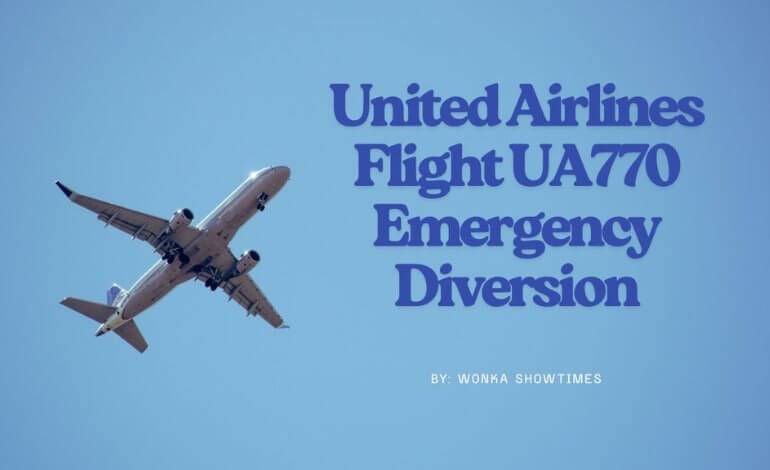
United Airlines Flight UA770 Emergency Diversion – What Really Happened in the Sky
In the world of aviation, safety is always the top priority. Commercial airlines undergo rigorous checks, and pilots are trained for every imaginable scenario. But even in such a controlled environment, unexpected events can occur—events that quickly grab headlines and spark questions. One such incident was the United Airlines Flight UA770 emergency diversion.
At Wonka Show Times, we dive beyond the headlines to uncover the full story. When passengers aboard UA770 found themselves landing at a different airport than planned, speculation spread fast. What caused the emergency? Was anyone in danger? And how did United Airlines respond?
This article examines the facts, the reactions, and the broader implications of the emergency diversion involving United Flight UA770.
What Is an Emergency Diversion?
Before getting into the specific case of UA770, it’s important to understand what an emergency diversion actually is. An emergency diversion is when a commercial flight must alter its route and land at an alternate airport due to an urgent issue. These can include:
- Mechanical or technical failure
- Medical emergencies onboard
- Cabin pressure issues
- Weather conditions
- Security threats or disruptive passengers
- Fuel concerns
Such decisions are made swiftly by the flight crew, often in coordination with air traffic control, to ensure the safety of everyone onboard.
Now let’s look at what happened on United Airlines flight UA770 emergency diversion.
Details of United Airlines flight UA770 emergency diversion
Flight UA770 is a regularly scheduled passenger service operated by United Airlines. While the route can vary depending on operational schedules, the incident in question involved a flight from a major city in the United States, bound for another domestic or international destination.
On the day of the emergency diversion, Flight UA770 took off as planned. The aircraft was a standard commercial jet, carrying both passengers and crew. Initial reports indicated normal operations during takeoff and early stages of the flight.
However, somewhere mid-flight, conditions changed, leading to what would soon be identified as the United Airlines Flight UA770 emergency diversion.
What Triggered the Emergency Diversion?
While airlines are often discreet about the exact nature of in-flight incidents, several credible sources and eyewitness reports help paint a picture of what unfolded on UA770.
Here are some of the possible scenarios discussed in relation to the incident:
1. Medical Emergency:
Some passengers reported that a fellow traveler appeared to be in distress. Cabin crew provided first aid, and the captain decided to divert the flight to the nearest suitable airport to get the individual medical assistance as quickly as possible.
2. Mechanical Malfunction:
Other sources suggested a potential technical issue with one of the aircraft systems. Although not life-threatening, the nature of the alert required immediate assessment on the ground rather than mid-air troubleshooting.
3. Pressurization Anomaly:
In some reports, passengers described a sudden discomfort in the ears or temperature changes in the cabin, possibly indicating a pressurization issue—one of the most common causes of emergency descents or diversions.
Despite the multiple reports, the exact cause was officially described as a “precautionary measure taken by the flight crew in response to an onboard irregularity.” While vague, this is common in public statements to avoid unnecessary panic or speculation.
The Diversion Process
Upon determining the need to divert, the pilot of United Flight UA770 initiated standard emergency protocols.
These typically involve:
- Contacting air traffic control to request priority landing clearance
- Informing the cabin crew and passengers of the decision
- Identifying and coordinating with the nearest airport with a suitable runway length and emergency services
- Preparing for potential evacuation or emergency response on landing
In this case, the flight was rerouted to a nearby major airport equipped with medical personnel, maintenance crews, and emergency response teams.
Passenger Reactions
As with most diversions, passengers on UA770 had mixed responses. Some were understandably anxious, especially if they were unaware of what triggered the emergency. Others praised the professionalism of the flight crew and how calmly the situation was handled.
Many shared their experiences on social media after landing, using phrases like:
- “Unexpected landing but handled well”
- “Crew was calm and informative.”
- “Medical team rushed in immediately upon landing.”
These firsthand accounts provide valuable insight into how the event unfolded from the cabin’s perspective and reinforce the importance of clear communication in managing in-flight incidents.
United Airlines’ Official Response
United Airlines issued a brief but direct statement following the incident, confirming the United Airlines Flight UA770 emergency diversion and reiterating their commitment to safety.
Key points from the statement included:
- Acknowledgment of the diversion
- Clarification that the aircraft landed safely without injury
- Assurance that affected passengers were rebooked or accommodated
- Praise for the flight crew’s quick response
United Airlines Flight UA770 emergency diversion also emphasized that such actions are part of their rigorous safety protocols, and diversions are never taken lightly.
What Happens After a Diversion?
Once the aircraft is safely on the ground, several things happen behind the scenes:
Inspection:
If the diversion was due to a mechanical issue, technicians perform a full systems check. In many cases, the aircraft is temporarily taken out of service for more thorough diagnostics.
Passenger Support:
Airline staff assist passengers with rebooking, arranging hotel accommodations, providing meal vouchers, and arranging transportation as necessary.
Medical Assistance:
If the diversion was for a medical reason, paramedics board the aircraft immediately to provide care and, if needed, transport the passenger to a hospital.
Crew Debriefing:
Pilots and flight attendants undergo a post-incident review to document the decision-making process and report any unusual occurrences.
For passengers, the goal is to continue the journey with as little disruption as possible. For the airline, it’s about ensuring safety while minimizing long-term impact on operations.
Frequency of Emergency Diversions
It’s important to note that emergency diversions, while dramatic-sounding, are relatively rare and almost always precautionary.
According to industry data:
- Less than 1 in 10,000 flights result in an emergency diversion
- The majority are related to medical issues, not aircraft failures
- Commercial aircraft are built with redundant systems, making in-flight emergencies very manageable
In fact, a well-handled diversion—such as what occurred on UA770—demonstrates the efficacy of airline training and preparedness rather than a failure.
Implications for Airline Safety
The UA770 incident is a reminder of why passengers should feel confident in modern air travel. Despite the unpredictability of emergencies, airlines like United are equipped with protocols and trained professionals to navigate such events efficiently.
Key takeaways include:
- Aircraft are constantly monitored for technical anomalies
- Pilots are trained to make swift, sound judgments under pressure
- Cabin crew play a vital role in calming and assisting passengers
- Emergency services at airports are well-prepared for such landings
The diversion may have caused delays, but it likely prevented a situation that could have escalated had it been ignored.
How Passengers Can Stay Prepared
While flying remains statistically the safest form of travel, passengers can still take simple steps to be better prepared in case of a diversion:
- Listen closely to safety instructions before takeoff
- Keep essentials like medications and chargers in your carry-on
- Stay calm and follow crew directions during unexpected changes
- Ask questions if you need clarity about what’s happening
Remember, in an emergency, your best resource is the trained professionals onboard.
Conclusion
The United Airlines Flight UA770 emergency diversion is a clear example of how the aviation industry prioritizes safety above all else. While it might have disrupted travel plans or sparked anxiety among passengers, it ultimately showcased how effective airline protocols are in managing unexpected situations.
At Wonka Show Times, we believe that stories like these deserve not just attention but context. Rather than focusing on fear or speculation, we aim to provide clear, accurate reporting that helps readers understand the reality behind such events.
Flight UA770’s successful diversion reminds us that while turbulence may hit, a calm response and quick action can ensure everyone arrives safely—even if it’s not at the original destination.
For more breakdowns of headline events and the truth behind trending news, keep following Wonka Show Times.





